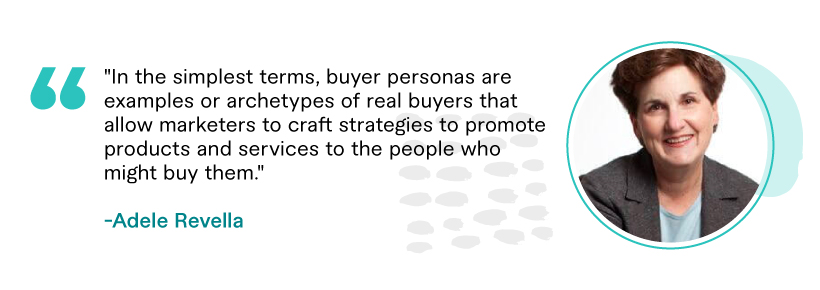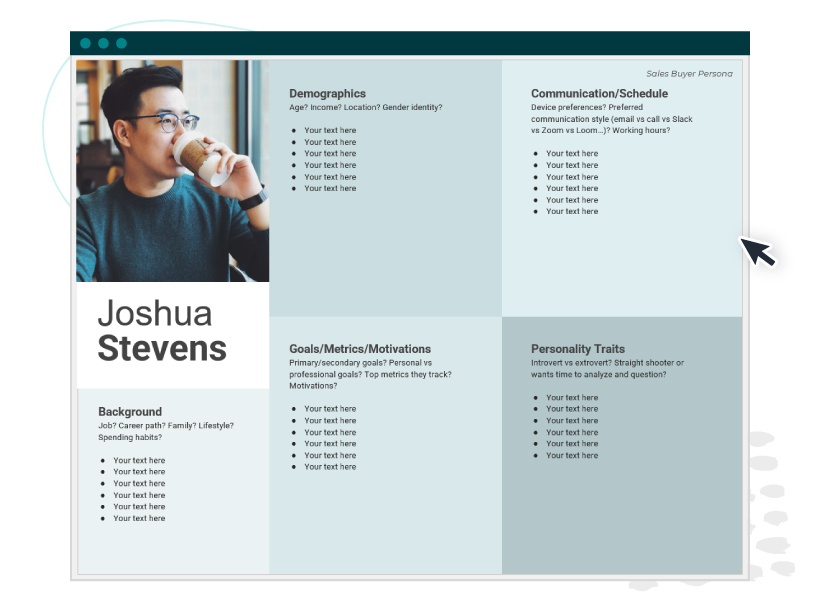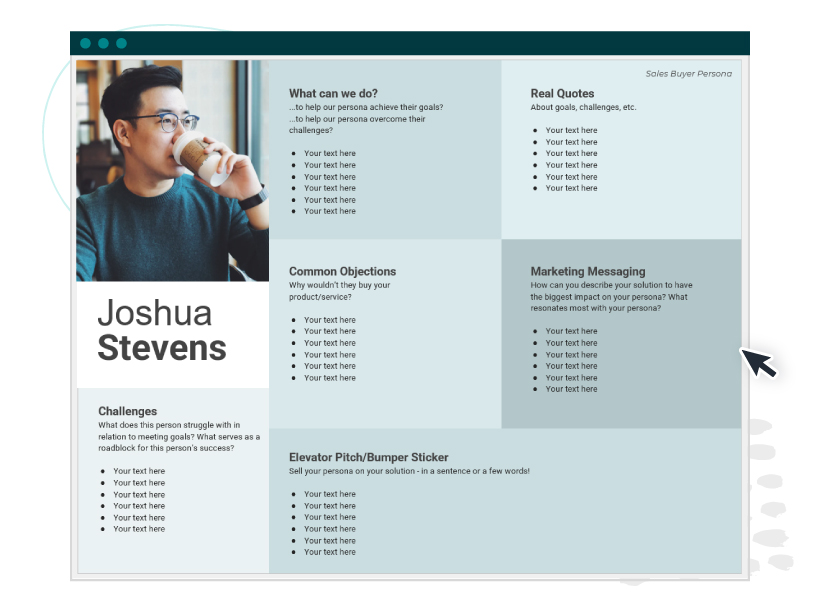IT Helpdesk Specialist, John. Virtual Assistant, Annette. Sales Manager, Sally. Marketing Manager, Mark.
There’s a good chance you’ve heard of them.
They’re called marketing personas. Although they’re not actual people. They’re based on real-life customers. Today’s marketers can’t live without them.
In this post, we’ll talk about marketing personas, why they’re important, and the best practices for creating one in 2024.

What is a marketing persona?
Marketing personas are sometimes also called buyer personas. They are semi-fictional, generalized representations of a company’s ideal customers.
These characters are created based on research, data, and insights from actual customers. Buyer personas can inform a wide range of marketing activities. Including content creation, advertising, and even product development.
They help marketers better understand their target audiences. Also, how to communicate with them more effectively. And on which channels they’re most likely to respond, among other things.
The number of marketing personas you will need depends on the products or services you offer and your target audience.
How have marketing personas changed in the past years?
Software designer and technology consultant Alan Cooper pioneered the use of personas in 1985.
To help him create a project management tool that was user-friendly, he interviewed a number of likely users, mostly colleagues. Out of those interviews, the user persona Kathy was born.
Later, as a business intelligence software consultant, he developed the personas Chuck, Cynthia, and Rob. These represented three distinct categories of users based on their goals, tasks, and skill levels.
In 1994, Angus Jenkinson proposed grouping people with similar attitudes. This concept led to more detailed personas that also explore buyers’ goals, values, frustrations, and motivations.
In later years, Clayton Christensen’s “jobs to be done” theory for creating personas took hold. It encouraged marketers to ask the questions:
- What is a person trying to get done?
- What jobs can the product do for the person “hiring” it?
The early 2000s saw the introduction of qualitative and quantitative personas. As well as the development of data-driven personas. In 2017, researchers launched AI-powered tools to automatically turn customer data into personas.

How to make a marketing persona
Creating buyer personas for your persona marketing strategy will involve a three-stage process:
Research your audience thoroughly
You need data to get started. Your marketing personas will reflect a wide range of information about your target consumers, including:
- Demographics: Age, gender, relationship status, location, education level, occupation, and income.
- Psychographics: Personality traits, values, beliefs, and attitudes toward specific topics, interests, hobbies, and lifestyles.
- Behaviors: Browsing behavior, decision-making processes, and communication preferences.
- Buying habits: Frequency and timing of purchases, what channels they prefer to buy from, and how much they’re willing to spend.
- Pain points: Challenges, problems, and obstacles they face that your product or service can solve.
- Goals and objectives: What they want to achieve, both personally and professionally.
- Preferred marketing channels: Preferred channels for gathering information, researching products, and seeking recommendations. For example, social media, search engines, email marketing, influencer marketing, etc.
- Communication style: Preferred tone and messaging style. For example, direct and to the point, friendly and informal, professional and formal, etc.
You gather this information through market research and analysis of the data you have about your existing customers.
Some strategies you can use:
- Conducting surveys, interviews, and focus groups.
- Analyzing your contacts database and sales data.
- Sending out customer feedback forms.
- Using tools such as Google Analytics, Facebook Audience Insight, and social media monitoring platforms. As well as AI-powered tools that gather real-time customer data from various sources.
- Conducting ethnographic field studies. This involves immersing researchers in customers’ environments to gain a deeper understanding of their attitudes and behaviors
- Checking forums and online review sites for what customers are saying about a product or service.
- Analyzing third-party market research reports on industry trends and customer behavior patterns.
- Conducting competitor analysis.
- Getting feedback from your sales team.
Develop your buyer personas
Now that you have the data, it’s time to build your personas.
1. Review the raw data
Take a hard look at the data you’ve collected to identify patterns and commonalities. Data visualization tools such as Tableau can help.
Next, group customers into segments based on common characteristics. For example, age, gender, location, and buying behavior. Within each segment, look for common traits and motivations such as pain points and goals.
2. Create detailed persona profiles
Using the information you’ve collected, build detailed profiles of each customer segment. Include information such as demographics, job titles, hobbies, interests, and common objections. Additionally, how your product or service can help them. Give each persona a name and backstory.
HubSpot, Semrush, and PersonaGenerator offer free templates you can use to create your personas.


Source: HubSpot
3. Validate your personas
Share your work with other members of the organization. Particularly those in sales and other customer-facing roles. The goal is to capture feedback on whether your personas are accurate or if there are any missing elements or descriptions.
You may also run customer surveys, interviews, or focus groups. These will help you determine whether your personas accurately represent customers’ needs, pain points, and preferences.
Analyze the feedback and update your personas, as necessary.
Refine your marketing personas
Customer needs evolve over time, and refining buyer personas is an ongoing process. This way, they remain effective at informing your marketing strategies and business decisions.
To update your buyer personas:
- Gather additional data from surveys, customer feedback, and other sources.
- Update personas based on new insights.
- Test and validate your personas to ensure they accurately reflect your customer base.
- Continually monitor and adjust your personas as new information becomes available.

Persona marketing in 2024
Personas will continue to play an essential role in marketing during 2024 and beyond. They represent your target customers. While providing a deeper understanding of their needs and preferences. This, in turn, allows you to create more effective marketing strategies. You can then tailor your messaging to each persona’s unique goals and motivations.
At ClearVoice, we create content that coincides with your target customers’ needs and expectations. To learn more, speak with our team today.



